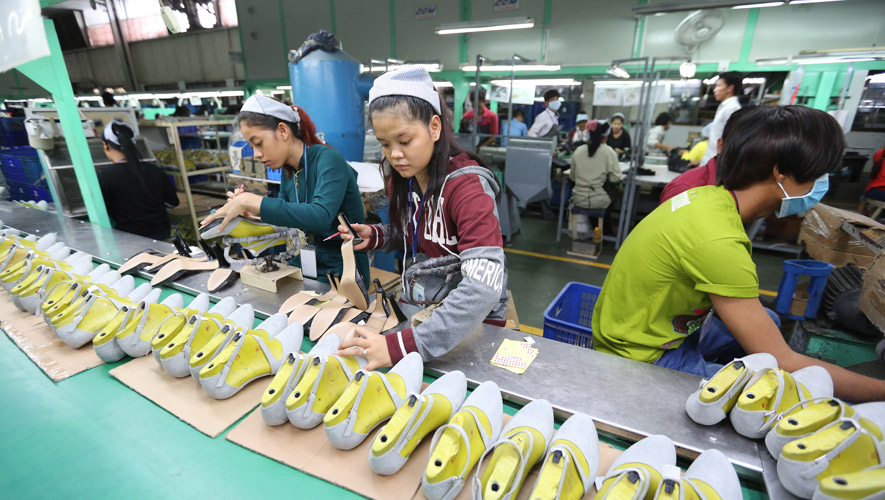Talks about China’s economic resilience and elasticity are nothing new. Following the 18th National Congress of the Communist Party of China, Xi Jinping stressed China is a huge country that is resilient, possesses elasticity, and holds potential as well as plenty of room for manoeuverability. He further emphasised China’s economic strength is particularly adept at preventing risks.
For the latest Cambodian Business news, visit Khmer Times Business
Resilience and elasticity are terms in physics commonly used to describe a material’s properties. Resilience is defined as a material’s ability to withstand damage when subjected to pressure and/or a substance’s capacity to absorb mechanical or kinetic energy until it is damaged. Elasticity refers to a material’s ability to return to its original form when force is exerted or the ability to reshape itself after being compressed. Should the material assume a different form upon removal of force and a certain degree of deformation occurs, we call that plastic deformation instead. When said force exceeds the material’s resistance, it will either deform or fracture. The words resilience and elasticity are associated with the economy here because they refers to the economic system’s ability to withstand and adjust to shocks.
In recent years, Chinese leaders have repeatedly discussed the issue of economic resilience, which arose from certain trends. One, China’s economy is having a hard time maintaining its past growth which has always been high and it is shifting from a rapid growth to slower one, causing the economic growth to stall from slow growth from time to time. For example, between 2010 to 2015, in just five years, China’s economic growth fell from 10.6 percent to 6.9 percent. Two, the Chinese leadership is promoting economic restructuring, with great efforts to reduce the economic leverage ratio to achieve economic growth model conversion and conversion of growth momentum. Three, the risk factors in China’s economy has increased and so has the risk in possibility for outbreaks, especially debt risk and financial risk.
The huge impact COVID-19 has on the global and China’s economy is putting its economic resilience to the test. Unlike the crises from 40 years ago or so, this time around, the pandemic has caused two months of economic activity in China to “freeze”, disrupting supply chains and causing consumption to come to a near halt. Clearly, the pandemic’s impact has triggered a test that will certainly determine the life or death of China’s economy
On top of that, the national economy is experiencing a full-scale decline. According to data from the National Bureau of Statistics of China, the domestic economy fell 6.8 percent year-on-year (y-o-y) in the first quarter, which was the first quarterly negative growth since the quarterly economic statistics in 1992. During the first quarter, the value-added of the industrial enterprises above designated size fell 8.4 percent y-o-y (down 1.1 percent y-o-y in March; between January to March, the total retail sales of consumer goods fell 19.0 percent y-o-y, a nominal decrease of 15.8 percent y-o-y in March); in the first quarter of 2020, China’s fixed-asset investment declined 16.1 percent y-o-y (reduced by 8.4 percentage points from January to February); for the first quarter, foreign trade of goods fell 6.4 percent, exports dropped 11.4 percent and imports slipped 0.7 percent; in the first quarter, the nationwide per capita disposable income of residents was 8,561 yuan, a nominal increase of 0.8 percent y-o-y – a real decrease of 3.9 percent post-price factors-deduction.
Hubei, the first to suffer from the contagion, lost 39.2 percent y-o-y in the first quarter this year. Among the few industries it has, the primary industry decreased 25.3 percent, secondary industry decreased 48.2% percent, while tertiary industry experienced a decline of 33.3 percent. Fixed asset investment in Hubei province dropped 82.8 percent y-o-y in the first quarter (infrastructure investment fell 84.4 percent, private investment fell 82.6 percent and industrial investment fell 85. percent). Moreover, the retail sales of consumer goods totalled 293.943 billion yuan, a y-o-y decrease of 44.9 percent. General budget revenue was 54.249 billion yuan, a decline of 47.6 percent. Among them, tax revenue was 43.404 billion yuan, a decrease of 45.9 percent. The general budget expenditure was 155.506 billion yuan, down 14.1 percent. In the first quarter, the per capita disposable income of urban permanent residents in the province was 9,412, down 11.8 percent; the per capital disposable income of rural permanent residents in the province was 4,085 yuan, down by 10.2 percent.
It was expected that the economic data of the whole country (Hubei included) would fall sharply. However, the economic downturn is not as severe as Anbound previously estimated, especially considering COVID-19’s impacts and the degree of economic freeze. Anbound’s’s chief researcher Chan Kung stated it’s an objective fact that the first quarter of economic data reflects China’s economic resilience. Once again, take Hubei for an example, the hardest-hit city and ground zero to the virus. The 76-day lockdown has caused its economy to freeze almost completely. Plagued with “wartime-like conditions”, all productions save for essential services were forced to shut down for a certain period, causing the province’s GDP to have a negative growth of 39 percent which is far below the previous estimate of a 50 percent drop.
With that said, the next question to ask is, what enabled Hubei as well as the rest of China’s economy to last during the first quarter of the year when things were visibly tough? More specifically, where exactly does China’s economy get its resilience? In our opinion, the answer lies in two economic activities. The first being the essential consumption activities derived from a large population and the second which are the basic infrastructures of the city such as water, electricity and heat that kept the economy going. Throughout the entire time the city was placed under a strict lockdown and traffic was nowhere to be seen, the basic act of eating, drinking, sleeping went on; as did other basic facilities such as water, electrical, heating, and other infrastructure operations. Chan Kung emphasised that it was thanks to the continual operation of essential services that the GDP’s negative growth dropped by 39 percent only and this is where the economy gets its grit. The same applies for other countries when a comparison was drawn and inferred. China’s urban infrastructure accounts for a large portion, not just in Hubei or Wuhan City, but also in its national statistics. So long as urban infrastructure such as water, electricity and heat remain in operation, it will be able to hold out and China’s large GDP growth is guaranteed, especially because it makes up for a considerable proportion of the country’s economy.
Online consumerism has become a fad over recent years. It is very much expected to suffer a loss too, the reason being that a part of the rapid growth in online consumerism stems from conventional methods of consumption, thereby causing the overall consumption growth to remain stunted in recent years. Seeing that the GDP contribution has fluctuated somewhat, the overall change is small. A case in point is the total retail sales of consumer goods that has fallen 19.0 percent y-o-y in the first quarter, while national online retail sales fell only 0.8 percent y-o-y. Among them, the online retail sales of physical goods also maintained a y-o-y growth of 5.9 percent, accounting for 23.6 of the total retail sales. Based on the consumption structure, what can be surmised is the emergence of a new group of consumers as compared with the past, that or some consumers have changed their consumption habits. Simply speaking however, so long as the population of consumer remains huge and ever functioning, consumption will forever be one of China’s most important pillars of support as far as resilience is concerned.
Economic resilience is a concept of crisis, which primarily targets economic downturn or difficult situations. It is largely dependent on soft and hard conditions such as population size, infrastructure system, logistics support system and online sales system. When it concerns reviving the economy, restoring economic prosperity, and improving economic quality, economic elasticity comes into discussion. To Anbound researchers, economic resilience does not equate to economic elasticity and vice versa. Economic elasticity depends on various factors such as economic structure, industrial structure, consumption structure, degree of marketisation, allocative efficiency, business environment, and public service quality. In short, to obtain better economic elasticity, China’s market must be reformed significantly.
The economic data for Hubei and China in the first quarter of 2020 shows the tenacity of China’s economy when faced with disaster. Having said that however, to achieve better economic elasticity, China’s market must first undergo a significant reform.
Chan Kung is partner, director of China Macro-Economic Research Team and senior researcher at Shanghai think tank Anbound




